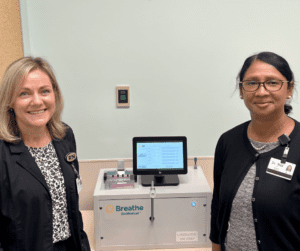
MONCTON, New Brunswick and CAMBRIDGE, Mass., February 25, 2025 – Breathe BioMedical, a company developing a breath analytics platform for early disease detection, today announced the launch of its first large multi-center observational collection protocol study to advance the development of its breath test for the early detection of breast cancer in women with dense breasts, as an adjunct to mammography. Breath sample collection has started at George Washington University Breast Center.
Dr. James Jakub, Surgical Oncologist and Professor of Surgery and Dr. Pooja Advani, Breast Medical Oncologist and Researcher, both of Mayo Clinic in Florida, will serve as Co-Principal Investigators of the study. Dr. David Barreto, Assistant Professor of Radiology at the George Washington School of Medicine and Health Sciences, is serving as Site Investigator. Researchers will compare the breath profiles of women with dense breasts with breast cancer and those without breast cancer, with the goal of identifying disease-specific patterns that can be leveraged to facilitate breast cancer detection.
“It is well understood that mammography alone is insufficient in detecting breast cancer for women with dense breast tissue, creating the need for accurate, and cost-effective adjunctive detection tools,” said Bill Dawes, CEO of Breathe BioMedical “This data collection initiative will expand our existing data inventory, allowing us to evaluate our machine learning models across a broader and more diverse population. It also provides an opportunity to further refine these models to enhance their predictive accuracy. We are honored to collaborate with esteemed research institutions such as the Mayo Clinic and George Washington University and look forward to expanding our network of clinical partners in the future.”
Approximately 50% of the 70 million women in the U.S. that are eligible for breast cancer screening have dense breast tissue, making them 4 to 5 times more likely to develop breast cancer than women without dense breast tissue. Although mammography is the current standard for breast cancer screening, the interpretation of a mammogram can be especially challenging with dense breast tissue, because both tumors and dense breast tissue appear white on a mammogram. Evidence suggests that the sensitivity of mammography alone drops to as low as 40% in women with extremely dense breast tissue.
About Breathe BioMedical’s Technology
Breathe BioMedical has developed Breath based disease detection technology that allows for individuals to provide a breath sample which can then be analyzed for combinations of biomarkers which may be indicative of disease. The breath sampler collects alveolar breath stored on industry standard sorbent tubes which are transported to our central laboratory. The sample is then processed using our proprietary Spectrometer, with detection capability in the parts per trillion, producing a spectrographic data set. The Machine Learning Algorithms (MLA) are applied to the spectrographic data set to identify disease biomarkers and patterns that are associated with breast cancer.
About Breathe BioMedical
Breathe BioMedical is developing an innovative breath analytics platform to enable the early detection of disease. Our proprietary technology is designed to collect, process and analyze breath samples to identify biomarker patterns associated with specific diseases. Breathe BioMedical is focused first on developing a breath test for breast cancer detection for women with dense breast tissue, as an adjunct to mammography, with the goal of increasing the number of breast cancer cases identified at the earliest stages. Breathe BioMedical is headquartered in Moncton, New Brunswick, with a US subsidiary in Cambridge, Massachusetts. At Breathe BioMedical we believe that our non-invasive, accessible technology will enable a stage shift in early disease detection saving lives and money when compared to existing standards of care.
For more information, please visit our website and follow us on LinkedIn.
# # #
Contacts:
Media: Will Chapman
communications@breathebiomedical.com


